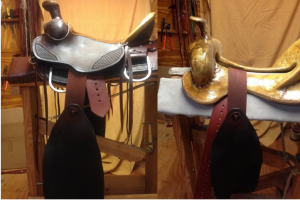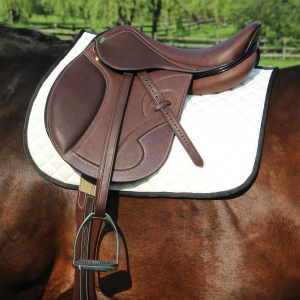It is that time of year again, where your saddle and leather tack probably have some mold and mildew on them. Have you ever wondered how to properly clean your tack, oil it, and finish/condition it? Don’t let that mold or mildew continue to grow on your leather, it can ruin it. Here are some helpful tips to clean, oil, and condition your saddle:
Cleaning:
- Keep leather items that are under frequent use as clean as it is practical
- Saddle parts that are in contact with your horse’s sweat can be cleaned after every use with a simple wipe down with a cloth
- Several times each year, saddles and bridles should receive a thorough cleaning
- Disassemble pieces if you need to
- Each item can be scrubbed with a good liquid Glycerin saddle soap, a sponge or cloth, and adequate water
- Avoid submerging your saddle with a water hose
- Bar and cake soaps can build up in tooling and stitching, which can make it difficult to rinse clean
- When cleaning and oiling your saddle make sure your stirrup leathers lose. This will help prevent breakage

Step 1: Disassemble leather straps and pieces for proper cleaning
Step 2: Scrub with a liquid Glycerin saddle soap, sponge/brush, & water
Step 3: Use a water hose with light pressure to rinse away soap and dirt
Step 4: Let saddle dry before applying oil or conditioner
Oiling:
- Leather cleaning removes oils from the leather and those essential oils must be replaced in order for the tack to remain flexible
- 100% pure neatsfoot oil is derived from livestock byproducts and is great for nourishing leather products
- Disadvantages to using only neatsfoot oil are in humid environments mildew can appear on your saddle
- You can also use extra virgin olive oil to condition saddles
- A void using corn or vegetable oils because they tend to promote the growth of mold

Step 1: Make sure the leather items are dry after the cleaning process.
Step 2: Oils will penetrate better if warmed.
Step 3: Place your leather items in the sun to “warm up” prior to warming.
Step 4: Make sure you do not over oil your leather items if kept in high humidity.
Step 5: Allow to dry after applying the oil
Step 6: Coat a finish to the leather (Conditioners or Lacquers)
Tip: One to two coats is sufficient enough to
Finishing:
- Lacquers do an excellent job of sealing and waterproofing
- Lacquers do an excellent job with preventing molds and mildews in southern climates
- Leather conditioners contain oil, natural waxes, and lanolin
- Leather conditioners enhance pliability, softness, and suppleness of the leather
- Apply with your finger tips and work into the leather
- After drying, any excess may be buffed with a soft cloth
Storage:
- Heat and humidity are tack’s enemies
- During summer months, try to store tack in an area where you can remove some of the moisture in the air
- A dehumidifier or an air conditioner will make for a drier environment
- Saddle covers help keep dust and dirt off of your saddles
Don’t forget
- Dirty saddles may be “scrubbed” using saddle soap and water
- Cleaning suede with a stiff plastic brush will help remove dust and dirt
- Rough-out saddles should be cleaned the same way as tooled or smooth saddles
- Don’t store saddles in hot and humid storage rooms
- Healthy leather in occasional use can and will harbor mold and mildew during humid weather
- Clean your tack in the wintertime, when it is not as hot outside
- Watch for mildew and mold and remove it if you see it on your tack
- Don’t forget to perform a safety check on your tack while you’re cleaning your tack

For more information: https://edis.ifas.ufl.edu/publication/AN303
 1
1
